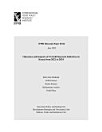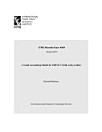Landscape complexity as determined by socioeconomic trends, climate change, and broad agricultural policies: A study on multifunctional landscapes
Cenacchi, Nicola · Petsakos, Athanasios · Robertson, Richard D. · Song, Chun · Mishra, Abhijeet
2025年7月 · IFPRI Discussion Papers 2343 巻 · Intl Food Policy Res Inst
電子書籍
55
ページ
family_home
利用可能
info
report評価とレビューは確認済みではありません 詳細
この電子書籍について
Food systems face dire challenges, including climate change, biodiversity loss, and resource overuse. To ensure their long-term sustainability and resilience they need urgent transformation, while continuing to support livelihoods and address rising food insecurity. The design and management of multifunctional agricultural landscapes offer a pathway to address these challenges; and improved understanding of landscape complexity, including a diverse mix of natural and cropland covers, can help advance achievement of multiple food system goals. As land managers and decision makers plan for the future of our landscapes, they need to recognize that powerful forces outside their control will have a strong influence on the final outcome. This study explores the interplay between global drivers—such as population growth, economic trends, climate change—and landscape complexity, using a modeling system linking a global agricultural economic model to a land-use model. Global trends are described, and Kenya serves as a case study, representing broader local dynamics. Results indicate that the majority of agricultural landscapes, globally and in Kenya, are projected to experience increased complexity by 2050, primarily through cropland expansion at the expense of natural habitats. However, there are a few instances where an expansion in cropland may be liked to a decrease in landscape complexity. Patterns also vary under alternative scenarios of agricultural development. Where greater complexity is achieved through policies that further concentrate agricultural land in some areas, this is mainly associated with net gains in natural habitats and a contraction of cropland. Overall, this preliminary research underscores the need for integrated landscape management and more comprehensive scenarios to inform sustainable land-use planning aligned with global food security and environmental objectives.
この電子書籍を評価する
ご感想をお聞かせください。
読書情報
スマートフォンとタブレット
Android や iPad / iPhone 用の Google Play ブックス アプリをインストールしてください。このアプリがアカウントと自動的に同期するため、どこでもオンラインやオフラインで読むことができます。
ノートパソコンとデスクトップ パソコン
Google Play で購入したオーディブックは、パソコンのウェブブラウザで再生できます。
電子書籍リーダーなどのデバイス
Kobo 電子書籍リーダーなどの E Ink デバイスで読むには、ファイルをダウンロードしてデバイスに転送する必要があります。サポートされている電子書籍リーダーにファイルを転送する方法について詳しくは、ヘルプセンターをご覧ください。








